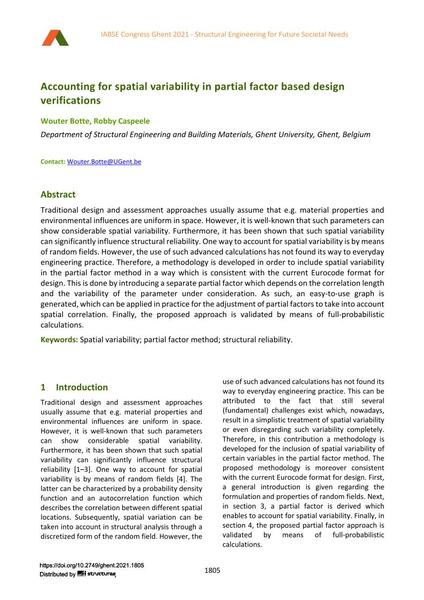Accounting for spatial variability in partial factor based design verifications

|
|
|||||||||||
Bibliografische Angaben
| Autor(en): |
Wouter Botte
Robby Caspeele |
||||
|---|---|---|---|---|---|
| Medium: | Tagungsbeitrag | ||||
| Sprache(n): | Englisch | ||||
| Tagung: | IABSE Congress: Structural Engineering for Future Societal Needs, Ghent, Belgium, 22-24 September 2021 | ||||
| Veröffentlicht in: | IABSE Congress Ghent 2021 | ||||
|
|||||
| Seite(n): | 1805-1812 | ||||
| Anzahl der Seiten (im PDF): | 8 | ||||
| DOI: | 10.2749/ghent.2021.1805 | ||||
| Abstrakt: |
Traditional design and assessment approaches usually assume that e.g. material properties and environmental influences are uniform in space. However, it is well-known that such parameters can show considerable spatial variability. Furthermore, it has been shown that such spatial variability can significantly influence structural reliability. One way to account for spatial variability is by means of random fields. However, the use of such advanced calculations has not found its way to everyday engineering practice. Therefore, a methodology is developed in order to include spatial variability in the partial factor method in a way which is consistent with the current Eurocode format for design. This is done by introducing a separate partial factor which depends on the correlation length and the variability of the parameter under consideration. As such, an easy-to-use graph is generated, which can be applied in practice for the adjustment of partial factors to take into account spatial correlation. Finally, the proposed approach is validated by means of full-probabilistic calculations. |
||||
| Stichwörter: |
Tragwerkszuverlässigkeit
|
||||
| Copyright: | © 2021 International Association for Bridge and Structural Engineering (IABSE) | ||||
| Lizenz: | Die Urheberrechte (Copyright) für dieses Werk sind rechtlich geschützt. Es darf nicht ohne die Zustimmung des Autors/der Autorin oder Rechteinhabers/-in weiter benutzt werden. |
||||
